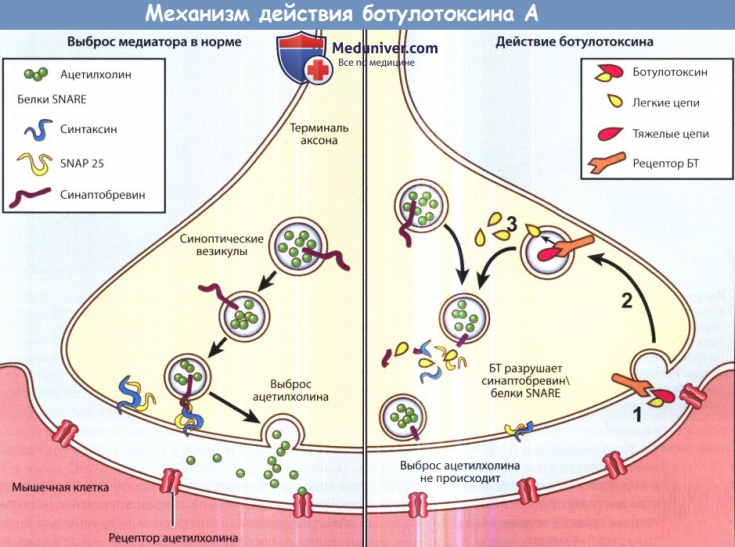– exotoxin produced by the bacteria Clostridium botulinum. BT induces a bilateral symmetrical neuroparalytic state. The word "botulism" comes from the Latin word «botulinum» – sausage. Botulism was so named during the Napoleonic Empire in the early 1800s, when it was noted that the disease was caused by eating spoiled sausage. The German physician Justinus Kerner later described plant botulism and its clinical symptoms between 1817 and 1822. In 1946, Shantz reported having isolated type A BT in its crystalline form, and almost a quarter of a century later, Alan Scott became the first to use the effects of BT in decapitated strabismus.
There are seven serotypes of BT (AG). In the article estet-portal.com you can get acquainted in detail with
the main characteristics of the types and subtypes of botulinum toxin.Mechanism of action of botulinum toxin
BT consists of three domains: a binding domain, a translocation domain, and an enzymatic domain. The binding domain is responsible for attachment to the presynaptic membrane (these receptors are specific to each BT serotype). Binding of the toxin initiates endocytosis of the molecule.
Within the endosome, the acidic environment creates a change in the translocation domain of the toxin, which allows the light chain to cross the endosome membrane and enter the cytosol. The enzymatic domain is released into the cytosol, the SNARE complex is destroyed, which consists of synaptoberevin, SNAP-25, syntaxin and provides transport of acetylcholine.
BT-A cleaves the SNAP-25 molecule between glutamine 197 and arginine 198. BT-B cleaves synaptobrevin between the amino acid residues of glutamine 76 and phenylalanine 77.
Follow us onFacebook Botulinum Toxin Types: What's the Difference
The term C. botulinum is best considered as a taxonomic descriptor for a group of strains/species that share the ability to produce botulinum neurotoxin.
Based on physiological characteristics and genetic background, these strains are grouped into 4 groups (labeled I-IV). The genetic differences between the groups are enough to justify designating each group as a separate species.
Each group tends to cluster with some other previously identified clostridial species, and the strains within each group produce a particular type of neurotoxin.
Seven serologically distinct neurotoxins (designated as AG neurotoxin types) are produced by strains/species of Clostridium.
Weight of knowledge about botulinum toxin type A subtypes in practice
Although all seven types (A, B, C, D, E, F, and G) have the potential to cause botulism in humans, only serotype A, B, E, and rarely F, have been reported to cause the disease. Clostridium botulinum, which produces toxin type A, is responsible for the highest death rate from botulism in humans.

Changes in the amino acid sequences in botulinum toxin may determine differences in its immunological and biological properties.
Five subtypes of botulinum toxin type A (A1-A5) have been identified. But only A1, A2 and A5 were purified and analyzed for functional differences. All five subtypes of Type A BT have similar binding affinity to SNAP25, but BT types A3 and A4 cleave SNAP25 with much less efficiency than A1 and A2.
Botulinum toxin A1 and A2 differ by approximately 10% in their amino acid sequences.
The main difference was found in the receptor binding domains. It was found that BT type A2 has a greater biological activity than A1. But the duration of action was the same in both subtypes of BT type A.

The diffusion potential of botulinum neurotoxins and their migration depend on a number of factors such as size and structure of the molecule, type of toxin, number of injections, protein load, muscle and site of injection.
Thank you for staying with estet-portal.com. Read other interesting articles in the "Cosmetology" section. You may be interested in
How to properly dose and administer botulinum toxin preparations







Add a comment